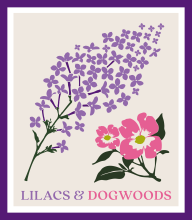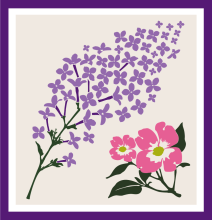Project Overview:

Your observations of lilac life cycle events can enhance the decades of lilac phenology records that have been collected across the U.S. as part of the Cloned Plants Project. Plant and observe a cloned lilac or report observations of a common lilac already established in your yard.
You're invited to participate in the Cloned and Common Lilacs Campaign by purchasing a cloned lilac and reporting phenology observations on it via Nature's Notebook. You can also participate by tracking a common lilac that is already established in your yard.
Why clones?
A lilac in New York blooms later than a lilac in Virginia. Why? One way to better understand the timing of spring phenology is by planting genetically identical plants, or clones, in different locations, and then to observe when they leaf out and flower. When observations are made on cloned plants, you can know with confidence that differences in the timing of flowering and leafing between different individuals is due to differences in local environmental conditions. Learn more about this research.
Consider contributing to this valuable effort by tracking a cloned lilac (Syringa x chinensis 'Red Rothomagensis') or common lilac (Syringa vulgaris) in your yard. We are also interested in observations of cloned dogwoods; if you live in the southeastern US, a cloned dogwood might be best for you.
See what Cloned and Common Lilac Campaign observers reported in 2024.
SIGN UP FOR Cloned and Common Lilacs MESSAGES!
You will receive messages full of findings, observation tips, and campaign-specific opportunities. Don't miss out!
HOW TO PARTICIPATE...
1. Obtain your cloned plants.
Cloned lilacs are available for purchase from JungSeed.com at a cost of $12 per plant.
If you prefer to track plants which are already established at your site, we also welcome observations on common lilac (Syringa vulgaris).
2. Join Nature's Notebook. If you haven't already, create a Nature's Notebook account. If you need more details on getting started, take the Observer Certification Course at learning.usanpn.org.
If you are tracking a cloned lilac, make sure to select Syringa x chinensis 'Red Rothomagensis' when adding the plant to your site.
3. Observe your plant(s). Report what you see (yes/no/not sure) on your plant periodically following the instructions for cloned lilacs. We encourage you to observe your plant(s) 2-4 times a week, especially in the spring, when things are changing rapidly. However, we welcome any observations you can contribute.
4. Report your observations. As you collect data during the season, log in to your Nature's Notebook account and enter the observation data you recorded. You can also use the Nature's Notebook mobile app to submit your observations!
EARN YOUR Cloned and Common Lilacs BADGE
See it on your Observation Deck.

Springcasting!
This spring, you will receive predictions of when your common lilac will leaf-out and flower, an effort we call springcasting. We will send you two emails this spring - one alerting you that your lilac should be leafing out in the next three days, and one alerting you that your lilac should bloom. Check your lilacs to see if the prediction is correct as soon after these emails as you can, and report your observations in Nature's Notebook.
These predictions will help you to more accurately capture the start of leafing and flowering on your lilacs.
What is springcasting?
When will plants break bud, when will the first open flower appear? Using mathematical models called the spring indices and near real-time weather reports, we are able to map the spread of spring across the nation nearly as it happens. We are calling this springcasting!
How do we do this?
We use historical information about when lilacs have leafed-out and bloomed in the past and what the climate was like preceding these events. We then use this information to develop models that can tell us, based on local weather forecasts, when lilacs are likely to leaf out and bloom in a particular year. Read more about these models, which are part of the Extended Spring Indices.
What can you expect next spring?
Each year, we send two emails to observers with a registered cloned (Syringa x chinensis 'Red Rothomagensis') or common lilac (Syringa vulgaris) - one alerting them that their lilac should be leafing out in the next three days, and one alerting them that their lilac should bloom. Observers are asked to check their lilacs to see if the prediction was correct as soon after these emails as possible and report their observations in Nature's Notebook.
Reports of leaf-out and flowering are much more valuable when observers also report the preceding date that they didn't see those events. That means that someone looking at the data will know that there was only a short period of time in between the last "no" observation and the first "yes" - to better pinpoint the onset! Observers are asked to report on their lilacs weekly throughout the spring to ensure that they captured the final "no" observation before the first "yes".
Why is this important?
Springcast predictions and the underlying models have value to agriculture, human health, wildland management, and more. Knowing when plants will undergo phenological changes can dramatically improve resource management and decision-making.
The models that predict the start of spring are being used by scientists to track how plants and animals are responding to climate change. This information is very valuable for preserving our natural resources, heritage, and way of life.
The start of spring is a US Global Change and Research Program Indicator. Predictions of the start of spring are also being used by the U.S. Government to track how plants and animals are responding to climate change. This information is valuable for preserving our natural resources, heritage, and way of life. Read more.
Cloned Plants Program Roots
For over 50 years cooperators in the United States and Canada have assisted phenological researchers by making phenological observations on cloned lilacs and honeysuckles. This program has now been incorporated into the USA-NPN's Cloned Lilac Campaign. Previously it had been part of the University of Wisconsin-Milwaukee's Indicator Observation Program. In addition to the cloned and common lilac, some participants in the UWM program observed cloned honeysuckle Lonicera tatarica 'Arnold Red'. Due to its invasive nature, honeysuckles have not been distributed to observers since 1987. The USA-NPN does not distribute the honeysuckle nor support its distribution, but we do welcome observations from historically established cloned honeysuckles.
Guidelines for planting cloned lilacs
Because representative data must be collected over many years, follow these guidelines when selecting the site for your observations.
- Choose an unshaded place, away from buildings, trees, or any other obstacles. (The minimum distance from the base of any obstacle should be at least two times the height of that obstacle).
- As much as possible, choose a place away from footpaths, sidewalks, and roads.
- At weather stations, plant the cultivars about 40 to 50 ft (12 to 15 m) away from the station to avoid any interference with the station instruments.
- Choose a place where you can observe the plants easily each day.
- Choose a place where there is no risk of the plants being trampled by people or animals.
- Choose a place where excessive amounts of snow do not accumulate from drifting or plowing.
- As much as possible, choose a level surface; if you have a hilly landscape, avoid, if possible, the low areas that can unduly delay shrub development in the spring.
- Plant in soil commonly found in the area; avoid planting in soil, such as a garden, that has received heavy applications of manure or compost.
- Leave at least 15 ft. (5 m) between plants.
- Choose a location that will not create any special microclimates (such as frost pockets or windy slopes) for the plants.